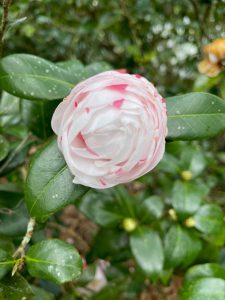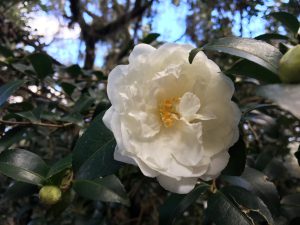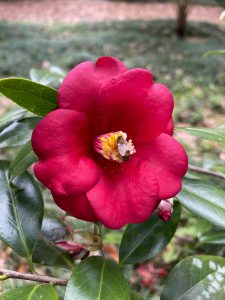Camellias are a delightful evergreen, flowering shrub choice for your fall to winter garden in Sumter County. Camellias came to America from Asia in the late 1700, and since 1900 southern gardeners have been planting them in their gardens.
Types of Camellias


The Camellia forms found in Florida gardens vary based on overall height and whether they are upright or spreading. There are several forms of Camellia flowers from single rows of petals to varieties that can be semi-double, double and peony-type. Camellias may have both solid and multi-colored blooms that can be attractive in any partially shady garden spot. The common Camellias typically used in Florida gardens include Camellia japonica (often called “japonicas” that bloom late winter/spring) or Camellia sasanqua (often called “sasanquas” that bloom mid fall to winter). They both have dark lustrous evergreen leaves, with C. japonica having larger leaves on larger plants, and C. sasanqua often having smaller leaves.
Selecting Camellias

There are several things to consider when purchasing Camellias. Choose healthy, vigorous plants. Read plant labels or research cultivars to plan for your selected camellia’s mature height and spread. Check for possible insects or diseases before purchasing. Camellias can be susceptible to insects like tea scale. Spider mites may cause leaf speckling on the leaves where they are sucking out chlorophyll. Aphids’ waste is honeydew which is stick substance which can lead to a sooty mold (removable). Look for leaf and bud galls which results in leaves or buds thicker and larger than normal leaves. Check container plants for healthy, well-formed roots by lifting
the plant out of the container. If you choose larger plants by balled-and-burlapped (B&B) plants, check the connection to roots. Choose camellias with a midseason bloom season which will provide more blooms.
Planting
It’s best to plant during late fall to very early spring (November to February). Dig the hole so that 90% of the plant is below ground with 10% above in an area two to three times with width of the ball. Add two-to-three inches of organic matter mixed in the top 12 inches of soil. After planting, mulch 2-3 inches up to the edge of the root ball, but to the trunk. Plant your camellias in part shade and not in an area where your landscape receives potentially colder winter winds.
Soils and pH
Flowering and success of the plant has a lot to do with the season of bloom and pH of the soil. Camellias prefer a more acidic soil with a pH range from 5.0 to 6.5. Soils can range from the lower pH to almost 8.5. You can modify your soils with organic matter or other soil amendments and may use an acidifying fertilizer for flowering plants. Check out the publication below for fertilizer suggestions and frequency for your camellias. One note is that they may experience magnesium deficiency. The best way to determine your pH, is to start with a soil test. Choose the $10 test to get the pH information and possible recommendations, as well as nutrient recommendation for the plants that prefer acidic soils.
There are a few other Camellias which you can read more about at “Camellias at a Glance” including a list of Camellias you may try in your garden at https://edis.ifas.ufl.edu/publication/EP002.
 0
0
